Richard Scaglion is a four-field anthropologist who specializes in the study of the Pacific Islands and has developing interests in Latin America. He is particularly interested in human migration and mobility in Oceania, in people’s relationships with their natural environments, and in the growth of social complexity. His applied work has involved the anthropology of law and sustainable development in island nations. He has a special relationship with the Abelam people of Papua New Guinea, with whom he has conducted long-term field research beginning in 1974.
Research Description
Professor Scaglion collaborates in a broad range of interdisciplinary projects aimed at unraveling questions about human adaptation in the Pacific Islands and beyond. An ongoing interest is in the prehistory, history, social development and contemporary life of the Abelam people of Papua New Guinea. Another recent project involves the dispersal of the sweet potato, a new world cultivar, throughout the Pacific Islands. This research has led him to consider the possibility of pre-Columbian human contact between Polynesia and South America, and has resulted in several new research projects in Ecuador. And recently he has worked collaboratively to produce a monograph about the Polynesian outliers, a group of small islands that lie outside the Polynesian triangle, to examine their relationships with their neighbors and with ancient Polynesia.
The Abelam People
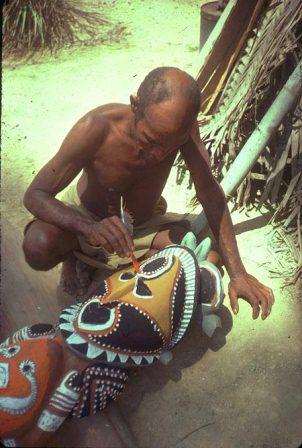
Famous for their artwork and for their majestic, towering spirit houses that dominate village skylines, the Abelam people are also well-known for growing and exchanging huge ceremonial yams that often exceed 3 meters (10 feet) in length. Dr. Scaglion has written about how yam beliefs act to organize and synchronize many aspects of Abelam life, and about how food is used in non-nutritive, symbolic and expressive ways.
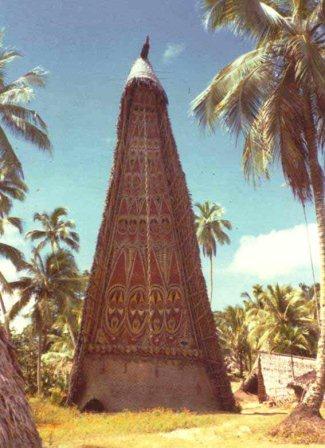
Abelam spirit house or temple in which many ritual activities take place.
Like many other peoples of New Guinea, the Abelam traditionally have an egalitarian social organization, lacking formal political offices and social hierarchies. How do they maintain social order with no police, courts, judges or jails? They have very rich ceremonial and social lives. How do they organize their activities without formal political or religious leaders?
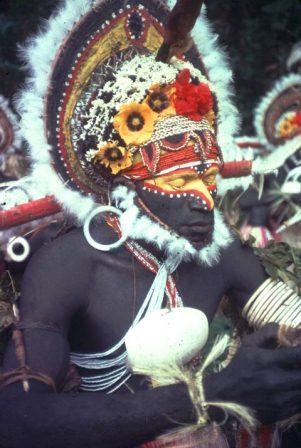
During elaborate male initiation ceremonies, costumed dancers with towering headdresses adorned with colorful feathers perform on the ceremonial ground in front of the temples.
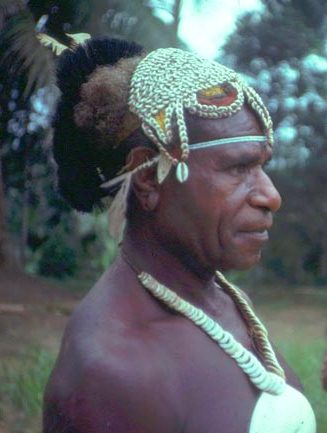
Abelam “big man,” a political figure who leads by influence but has no formal authority.
In some parts of the Pacific islands, most notably in eastern Polynesia, there are complex chiefdoms with formal leaders who orchestrate public works. How and why did these chiefdoms arise? Why didn’t they develop in the mountains of New Guinea, which has dense populations based on agricultural intensification and other characteristics generally associated with the growth of social differentiation?
Dr. Scaglion has examined these and other questions in over forty years of work with the Abelam people. He has described their conflict management techniques in his PhD thesis, studied their social organization, worked on legal development projects to establish Village Courts (which blend together introduced and customary legal systems) in their territory, and has assisted in their efforts to achieve sustainable economic development.
Diffusion of the Sweet Potato in the Pacific Islands
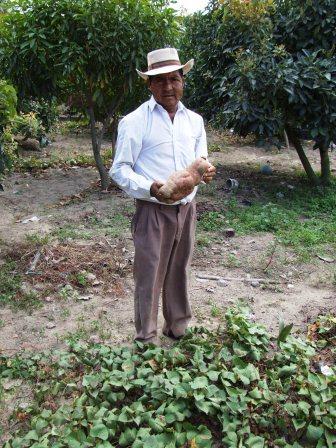
The sweet potato (Ipomoea batatas) was important in many agricultural systems throughout the Pacific Islands long before Europeans arrived. Yet botanists have established that the cultivar was first domesticated in the New World, probably in South America. How and when did it arrive in the Pacific Islands? Archaeological research indicates the presence of sweet potatoes in central Polynesia more than 1,000 years ago, and linguistic evidence suggests a human-mediated introduction. The word kumara is used throughout the Pacific islands and also in parts of South America, suggesting the introduction of the sweet potato into the Pacific could have been effected by Polynesian voyagers who sailed to the west coast of South America, collected the tuber, and brought it back to Polynesia. From there it may have spread more widely throughout the Pacific. Currently, DNA fingerprinting techniques are being applied to sweet potato samples to test hypotheses about the spread of sweet potatoes in Oceania and the influence of European-era introductions on modern diversity. The movement of sweet potatoes throughout the Pacific can teach us much about human migration and mobility in Oceania.
The Polynesian Outliers
Outside of Polynesia, in areas commonly designated Micronesia and Melanesia, lie about two dozen islands, most of them small and widely separated, whose inhabitants speak Polynesian languages and share other characteristics with triangle Polynesians. These islands are collectively termed the Polynesian outliers. While the great Polynesian centers endured major disruptions before trained observers had an opportunity to record their lifeways, many of the outliers, owing mainly to their remote locations, experienced much less social change, making them particularly interesting for anthropologists, and critical for the comparative study of Polynesia. Who are these peoples? Where did they originate, and how did they come to settle in these remote islands? What is their relationship to the better-known Polynesian societies? Can they, in some way, be thought of as representing Polynesian society before it became permanently altered by contact with Europeans? Dr. Scaglion has collaborated with many anthropologists who have worked in these islands to produce a new volume exploring these and other questions and to provide the first synthetic, comparative treatment of the Polynesian outliers. [Figure 6] The settlement and development of these remote outposts of Polynesia can also teach us much about human migration and mobility in Oceania.
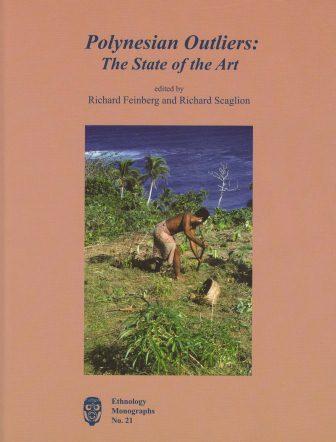
Feinberg, Richard and Richard Scaglion (eds.) Polynesian Outliers: The State of the Art. Ethnology Monographs No. 21, 2012.
Courses
Professor Scaglion is no longer teaching courses.
Survey Courses
Introduction to Cultural Anthropology
Anthropology is the study of humanity through time and across the globe. Cultural anthropology concentrates on the comparative analysis of living and recent human societies. By examining the behavior and customs of peoples throughout the world, this course considers what it means to be human. We investigate patterns of language and learning, marriage and family organization, warfare and violence, political and economic systems, beliefs and ritual life, etc., of people throughout the world, and compare them with social patterns in the United States. We also explore themes that unite contemporary peoples in a transnational, globalizing world.
Cultures of the Pacific
The South Pacific has a certain romantic appeal in popular imagination: swaying palm trees, mild tropical breezes, unspoiled, uninhibited people. Is this true? What are the people of this region really like? How do they feel about these popular images of themselves? What can we learn about human nature by studying the cultures of the South Pacific?
This class uses information about the peoples and cultures of Oceania as a vehicle for exploring basic anthropological ideas and concepts. In examining the customs of traditional Pacific peoples, we probe the ranges of human diversity, and by comparing these with very different American social patterns, we increase our understanding of what it means to be human. Students in this class also gain a greater appreciation of anthropology as a profession as they read firsthand the "field experiences" of several anthropologists.
The course treats both the traditional and contemporary cultures of the three major areas of the Pacific: Polynesia, Melanesia and Micronesia. It includes a geographical and historical introduction to Oceania as well as an examination of its contemporary social and political status.
Undergraduate Seminar
Anthropological Theory
This course is an overview of the major social theories and debates that stimulate and inform anthropological analysis. We investigate a range of theoretical directions in anthropology such as social evolution, historical particularism, functionalism, cultural ecology, ethnoscience and cognitive approaches, symbolic anthropology and postmodernism; and topics such as culture, social change, structure, agency, subjectivity, power, and the politics of representation. Requirements center around a close critical reading of primary texts in the history of anthropological thinking that are collected together in Anthropological Theory by McGee and Warms. The course provides an opportunity for students to learn about the development of central theoretical issues and assumptions in anthropology, gain familiarity with key writings of the major historical figures, understand essential aspects of the major theoretical paradigms that have inspired the discipline together with their historical contexts, and expand their critical thinking skills through evaluation of the strengths and weaknesses of different theoretical paradigms. Because contemporary anthropological theory is built upon earlier works, students are introduced both to the history of ideas and to current directions.
Graduate Seminars
Anthropology and Ecology
The course provides an overview of Ecological Anthropology tailored towards the interests of students who enroll. Ecological Anthropology focuses on the complex relations between people and their environments. It explores how culture influences the dynamic interactions between human populations and the ecosystems in their habitats through time. Ecological Anthropology is a relatively new field, having developed mainly since the 1950s. It is now a recognized topical specialization that crosscuts the traditional subfields of anthropology with its own separate unit within the American Anthropological Association called the Anthropology and Environment Section.
Special Topics in Pacific Islands Studies
The course uses the cultures of the Pacific Islands (including Polynesia, Melanesia, Micronesia, and Australia) as a framework for examining problems of general anthropological interest tailored to the interests of the students in the course. These may include such issues as the contributions of Pacific ethnology to anthropological theory; the interrelationships between people and the natural environment; the nature of gender; the origins of agriculture, the nature and development of social stratification, trade and exchange, and the nature of prestige-based economies; development issues such as health care delivery and educational services in a globalizing world, etc. The course will include an ethnographic survey of the Pacific area and an examination of contemporary problems in the region.
Pacific Prehistory
The course provides a basic survey of the prehistory of the Pacific Islands including an investigation of how they were settled, but its primary purpose is to use the cultures of the Pacific Islands (including Polynesia, Melanesia, Micronesia, and Australia) as a framework for examining problems of general interest to both prehistorians and ethnographers. These may include such issues as the origins of agriculture, the nature and development of social stratification, the interrelationships between people and the natural environment, trade and exchange, the nature of prestige-based economies, etc. These and other issues will be explored through lectures, class discussions, and readings